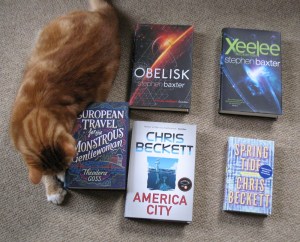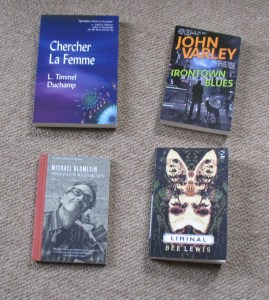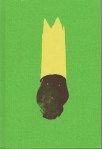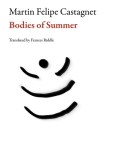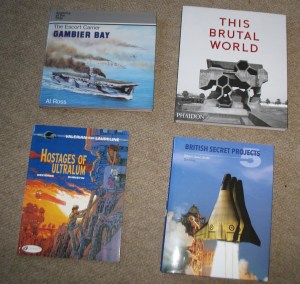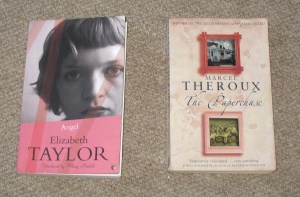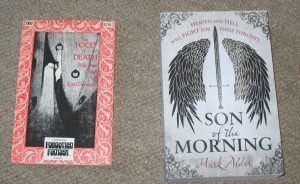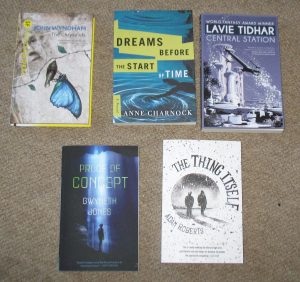In 2020, I read 105 books by 75 authors. Seventeen of them were rereads. Forty-five percent were science fiction, thirteen percent were fantasy, and nine percent were mainstream. Just over half (52%) were by male writers and 38% by women writers. The remainder were either non-fiction, graphic novels or had more than one author. I apparently didn’t read any anthologies. The authors were from the UK, US, Barbados, Belgium, Canada, France, Israel, Malaysia, New Zealand, Russia and Sweden.
Some of the books below I finished last year. Some of them I read this year. Usually, during the Christmas holiday I read a book a day but, thanks to the pandemic, I spent Christmas on my own and didn’t feel much like picking up a book. It wasn’t until the second week of January, which I’d booked as holiday, that I started reading again… and I managed six books over ten days… And I seem to be maintaining that reading pace.
 London Rules, Mick Herron (2018, UK). The fifth book of the Herron’s soon-to-be-televised Slough House / Jackson Lamb series, and it’s more of the same – offensive incompetents who manage to out-perform the best of MI5, chiefly, we are supposed to believe, because Lamb’s leadership is not hamstrung by all the politicking that goes on among the organisation’s upper echelons. A series of weirdly ineffective terrorist attacks persuade the Slow Horses that some unknown actor is following a playbook put together by the British government in the 1920s to destabilise nations which either threaten the British Empire or need a little persuading in order to “join” the British Empire. The whole thing is intended to embarrass HMG, but, of course, the current shower of shits in charge of the UK have proven HMG is immune to embarrassment – and indeed that neither blatant corruption nor outright lying to the public is unacceptable, never mind indirectly causing the deaths of hundreds of thousands of people, through their policies before and the pandemic now. Herron’s thinly-disguised caricatures of UK political figures are more annoying than amusing. It all seems very middle-class – the nudge-nudge-wink-wink offensiveness, the cynical acceptance of injustice, the commentary-free amorality… Still, only one more to go.
London Rules, Mick Herron (2018, UK). The fifth book of the Herron’s soon-to-be-televised Slough House / Jackson Lamb series, and it’s more of the same – offensive incompetents who manage to out-perform the best of MI5, chiefly, we are supposed to believe, because Lamb’s leadership is not hamstrung by all the politicking that goes on among the organisation’s upper echelons. A series of weirdly ineffective terrorist attacks persuade the Slow Horses that some unknown actor is following a playbook put together by the British government in the 1920s to destabilise nations which either threaten the British Empire or need a little persuading in order to “join” the British Empire. The whole thing is intended to embarrass HMG, but, of course, the current shower of shits in charge of the UK have proven HMG is immune to embarrassment – and indeed that neither blatant corruption nor outright lying to the public is unacceptable, never mind indirectly causing the deaths of hundreds of thousands of people, through their policies before and the pandemic now. Herron’s thinly-disguised caricatures of UK political figures are more annoying than amusing. It all seems very middle-class – the nudge-nudge-wink-wink offensiveness, the cynical acceptance of injustice, the commentary-free amorality… Still, only one more to go.
 The Kon-Tiki Quartet 4: Iterations, Eric Brown & Keith Brooke (2020, UK). The final novella and the story comes full circle, in a number of ways. Earth has sent a ship containing copies of the personalities of the scientists who worked on the project to colonise an exoplanet . They’re decanted into bodies created by “somatic printers” on arrival. The protagonist discovers that the local fauna produce a substance which, when processed, allows humans to read each other minds. This is liable to change human society on the exoplanet. Unfortunately, a group of militant eco-terrorists have infiltrated the colony and attempt to seize control. Their coup fails, but another set of copies of them heads back to Earth, which has suffered climate crash. This fourth book starts as the bad guys and good guys arrive in orbit about Earth. Both descend to the surface, to Norfolk, where the original starship was launched 200 years previously. In the two centuries since launch, Earth has regressed, with people barely capable of speech enslaved by “Long People”, who prove to be the original eco-terrorists who have stretched their lifetimes by printing new bodies for themselves when the old ones run down. But the printers too are running down, and each new generation of printed body suffers from “transcription errors”. This is solid science fiction of a sort that’s been around since the 1970s. The villains are perhaps a bit pantomime, but it makes a nice change that the protagonists are just plain ordinary and it’s not the universe at stake.
The Kon-Tiki Quartet 4: Iterations, Eric Brown & Keith Brooke (2020, UK). The final novella and the story comes full circle, in a number of ways. Earth has sent a ship containing copies of the personalities of the scientists who worked on the project to colonise an exoplanet . They’re decanted into bodies created by “somatic printers” on arrival. The protagonist discovers that the local fauna produce a substance which, when processed, allows humans to read each other minds. This is liable to change human society on the exoplanet. Unfortunately, a group of militant eco-terrorists have infiltrated the colony and attempt to seize control. Their coup fails, but another set of copies of them heads back to Earth, which has suffered climate crash. This fourth book starts as the bad guys and good guys arrive in orbit about Earth. Both descend to the surface, to Norfolk, where the original starship was launched 200 years previously. In the two centuries since launch, Earth has regressed, with people barely capable of speech enslaved by “Long People”, who prove to be the original eco-terrorists who have stretched their lifetimes by printing new bodies for themselves when the old ones run down. But the printers too are running down, and each new generation of printed body suffers from “transcription errors”. This is solid science fiction of a sort that’s been around since the 1970s. The villains are perhaps a bit pantomime, but it makes a nice change that the protagonists are just plain ordinary and it’s not the universe at stake.
 The Further Adventures of Sherlock Holmes – The Martian Menace, Eric Brown (2020, UK). Apparently, there are several of these The Further Adventures of Sherlock Holmes novels published by Titan Books. I’m not a Holmes fan, but Eric is a friend of many, many years and I do like his books. The Martian Menace is an expansion of a novella, The Martian Simulacra, published back in 2018 by NewCon Press. In that novella, a mashup of Doyle and Wells, Sherlock Holmes and Dr Watson are flown to Mars to solve the murder of an important Martian philosopher. But it’s all a ruse, as the Martians are replacing important individuals (only the British ones are named, of course, as this is Edwardian fiction; much like in US genre fiction) and replacing them with robots indistinguishable from the originals. But Holmes and Watson escape this fate with the help of an enterprising young woman from the resistance (comprised of humans wise to the Martians’ plans and the Martian enemies of those Martians who have been welcomed on Earth). The Martian Menace takes this story, and then does something very clever with it. Dragging Moriarty into the story is perhaps a no-brainer. Brown positions Moriarty as the architect of the Martians’ plot, but only by creating a multitude of simulacra of him… and it is the fate of the original Moriarty which proves to be the driver behind the plot of the novel and the enabler of its resolution. Reading this novel was an odd experience. It was as if the novella were two-dimensional, and the novel suddenly added a third dimension. Perhaps read from fresh, without knowledge of the novella, The Martian Menace would read as an inventive take on Sherlock Holmes meets Wells’ Martians. But having, read the novella, the novel went from the familiar to a quite unexpected place. I enjoyed it more than I expected.
The Further Adventures of Sherlock Holmes – The Martian Menace, Eric Brown (2020, UK). Apparently, there are several of these The Further Adventures of Sherlock Holmes novels published by Titan Books. I’m not a Holmes fan, but Eric is a friend of many, many years and I do like his books. The Martian Menace is an expansion of a novella, The Martian Simulacra, published back in 2018 by NewCon Press. In that novella, a mashup of Doyle and Wells, Sherlock Holmes and Dr Watson are flown to Mars to solve the murder of an important Martian philosopher. But it’s all a ruse, as the Martians are replacing important individuals (only the British ones are named, of course, as this is Edwardian fiction; much like in US genre fiction) and replacing them with robots indistinguishable from the originals. But Holmes and Watson escape this fate with the help of an enterprising young woman from the resistance (comprised of humans wise to the Martians’ plans and the Martian enemies of those Martians who have been welcomed on Earth). The Martian Menace takes this story, and then does something very clever with it. Dragging Moriarty into the story is perhaps a no-brainer. Brown positions Moriarty as the architect of the Martians’ plot, but only by creating a multitude of simulacra of him… and it is the fate of the original Moriarty which proves to be the driver behind the plot of the novel and the enabler of its resolution. Reading this novel was an odd experience. It was as if the novella were two-dimensional, and the novel suddenly added a third dimension. Perhaps read from fresh, without knowledge of the novella, The Martian Menace would read as an inventive take on Sherlock Holmes meets Wells’ Martians. But having, read the novella, the novel went from the familiar to a quite unexpected place. I enjoyed it more than I expected.
 The Stone Sky, NK Jemisin (2017, USA). The final novel in the Broken Earth trilogy, each book of which won the Hugo Award for best novel in three successive years. The first, The Fifth Season, was a worthy winner, but I’m not so convinced books two and three were. To be fair, neither 2017 nor 2018 had particularly good shortlists. There were perhaps a couple of books more deserving on the 2018 shortlist, but the 2017 one was pretty awful. Anyway, that’s neither here nor there. The Broken Earth trilogy is a good trilogy, and while the second book, The Obelisk Gate, does the usual treading water thing, The Stone Sky is very much a conclusion, and actually takes the story in a direction not hinted at in earlier volumes. It also deliberately positions itself as far-future science fiction, while still presenting its ideas as fantasy tropes. In hindsight, I suspect the trilogy is a good candidate as a future genre classic. It does interesting things with narrative in the first book, the worldbuilding is excellent, it makes a series of important points about race and slavery, and it manages to build up to a big, if not entirely plausible, idea that provides a fitting capstone. Essun, and her daughter Nassun, both powerful orogenes who can control the obelisks, make their way independently to Corepoint, a research station/city in the middle of the ocean on the other side of the planet to the Stillness. Both have the same aim – stopping the cycle of seasons (by returning the Moon to its orbit) – although at the prompting of different factions of stone eaters. A narrative thread set in the past reveals the origin of both the obelisks and the stone eaters. It’s all fascinating stuff, and if the villain of the piece, as revealed in the final chapters, takes a bit of swallowing, there’s no denying Jemisin’s ambition. And, to be fair, she nails it. I still don’t think all three books deserved to win a Hugo, but I do think the trilogy belongs in the “canon” of great sf works.
The Stone Sky, NK Jemisin (2017, USA). The final novel in the Broken Earth trilogy, each book of which won the Hugo Award for best novel in three successive years. The first, The Fifth Season, was a worthy winner, but I’m not so convinced books two and three were. To be fair, neither 2017 nor 2018 had particularly good shortlists. There were perhaps a couple of books more deserving on the 2018 shortlist, but the 2017 one was pretty awful. Anyway, that’s neither here nor there. The Broken Earth trilogy is a good trilogy, and while the second book, The Obelisk Gate, does the usual treading water thing, The Stone Sky is very much a conclusion, and actually takes the story in a direction not hinted at in earlier volumes. It also deliberately positions itself as far-future science fiction, while still presenting its ideas as fantasy tropes. In hindsight, I suspect the trilogy is a good candidate as a future genre classic. It does interesting things with narrative in the first book, the worldbuilding is excellent, it makes a series of important points about race and slavery, and it manages to build up to a big, if not entirely plausible, idea that provides a fitting capstone. Essun, and her daughter Nassun, both powerful orogenes who can control the obelisks, make their way independently to Corepoint, a research station/city in the middle of the ocean on the other side of the planet to the Stillness. Both have the same aim – stopping the cycle of seasons (by returning the Moon to its orbit) – although at the prompting of different factions of stone eaters. A narrative thread set in the past reveals the origin of both the obelisks and the stone eaters. It’s all fascinating stuff, and if the villain of the piece, as revealed in the final chapters, takes a bit of swallowing, there’s no denying Jemisin’s ambition. And, to be fair, she nails it. I still don’t think all three books deserved to win a Hugo, but I do think the trilogy belongs in the “canon” of great sf works.
 We Have Always Lived in the Castle, Shirley Jackson (1962, USA). A US classic, I’m told, but other than the title, I knew nothing about it. A copy popped up for 99p on Kindle, so I thought it worth a go. The novel opens with the sort of declarative introduction used by Holden Caulfield in Catcher in the Rye, a US literary technique, I think – in which the novel’s narrator reveals she is eighteen, has a somewhat warped view of the world, is despised by the inhabitants of the village in which she lives, and resides alone with her older sister in a large house on the outskirts. It’s gradually disclosed the family were poisoned some years previously, and the older of the two women was charged but then acquitted. A male cousin comes to visit, and gradually takes over the women’s lives, incurring the resentment of the younger. And eventually changing their situation profoundly, although perhaps not in the way he wanted. Is it a classic? I’m not sure… The central twist is obvious a handful pf pages in, and doesn’t really add much to the narrative. The narrator’s worldview is… individual. But the book still feels it belongs on a straight line from Catcher in the Rye, and Salinger’s novel is not a book I hold in high regard. I suspect it’s a novel I simply don’t have the cultural baggage to fully appreciate – which is something a lot of US critics and commentators should acknowledge, particularly in genre, as they seem to think the entire planet shares their worldview, sensibilities and culture. I may share a language with US citizens, but that’s all I share.
We Have Always Lived in the Castle, Shirley Jackson (1962, USA). A US classic, I’m told, but other than the title, I knew nothing about it. A copy popped up for 99p on Kindle, so I thought it worth a go. The novel opens with the sort of declarative introduction used by Holden Caulfield in Catcher in the Rye, a US literary technique, I think – in which the novel’s narrator reveals she is eighteen, has a somewhat warped view of the world, is despised by the inhabitants of the village in which she lives, and resides alone with her older sister in a large house on the outskirts. It’s gradually disclosed the family were poisoned some years previously, and the older of the two women was charged but then acquitted. A male cousin comes to visit, and gradually takes over the women’s lives, incurring the resentment of the younger. And eventually changing their situation profoundly, although perhaps not in the way he wanted. Is it a classic? I’m not sure… The central twist is obvious a handful pf pages in, and doesn’t really add much to the narrative. The narrator’s worldview is… individual. But the book still feels it belongs on a straight line from Catcher in the Rye, and Salinger’s novel is not a book I hold in high regard. I suspect it’s a novel I simply don’t have the cultural baggage to fully appreciate – which is something a lot of US critics and commentators should acknowledge, particularly in genre, as they seem to think the entire planet shares their worldview, sensibilities and culture. I may share a language with US citizens, but that’s all I share.
 The Day of the Triffids, John Wyndham (1951, UK). This is one of those books where one element of the story has entered public consciousness and actually drowned out the actual, well, story of the book. So everyone knows about the triffids, ambulatory plants which can kill by means of a whip-like stinger. Most people who haven’t read the book probably assume the triffids are alien, but the book actually suggests they were created in a Soviet laboratory. I’ve seen a couple of adaptations of the novel, and I had still forgotten that the entire plot, and menace of the triffids, is predicated on a global outbreak of blindness, caused by lights in the night sky (conveniently forgetting that half the planet would not be in darkness), initially blamed on a comet, but later implied it might have a human technological cause. The protagonist is not blinded because he was in hospital with his eyes bandaged, and the story is basically his survival story, along with the other few who were not blinded, and the various factions the sighted people have separated into. And all the while avoiding the triffids. I did at first wonder why the two things – blindness and triffids – when one or the other on their own would have provided sufficient drama. But the triffids are too easy to avoid by sighted people, and blindness alone wasn’t enough to cause human civilisation to collapse in such a short time-frame. The Day of the Triffids is definitely a book of its time – not just the sexism, but the comfortable middle-classness (so much so, one character in the book can “translate” from working-class to middle-class; this is, I hasten to add, British class, not American, and the two are not the same), and the relative ease with which the survivors manage to build sustainable communities. There’s a blink-and-you-miss-it condemnation of fascism, but this novel, like many of Wyndham’s novels, is a pretty good example of a “comfortable catastrophe”. I enjoyed it, but it was a much lighter read than I’d expected, and it’s certainly a well-known historical sf novel… but one for those eager to explore the history of the genre, including those novels some would have you believe are not genre…
The Day of the Triffids, John Wyndham (1951, UK). This is one of those books where one element of the story has entered public consciousness and actually drowned out the actual, well, story of the book. So everyone knows about the triffids, ambulatory plants which can kill by means of a whip-like stinger. Most people who haven’t read the book probably assume the triffids are alien, but the book actually suggests they were created in a Soviet laboratory. I’ve seen a couple of adaptations of the novel, and I had still forgotten that the entire plot, and menace of the triffids, is predicated on a global outbreak of blindness, caused by lights in the night sky (conveniently forgetting that half the planet would not be in darkness), initially blamed on a comet, but later implied it might have a human technological cause. The protagonist is not blinded because he was in hospital with his eyes bandaged, and the story is basically his survival story, along with the other few who were not blinded, and the various factions the sighted people have separated into. And all the while avoiding the triffids. I did at first wonder why the two things – blindness and triffids – when one or the other on their own would have provided sufficient drama. But the triffids are too easy to avoid by sighted people, and blindness alone wasn’t enough to cause human civilisation to collapse in such a short time-frame. The Day of the Triffids is definitely a book of its time – not just the sexism, but the comfortable middle-classness (so much so, one character in the book can “translate” from working-class to middle-class; this is, I hasten to add, British class, not American, and the two are not the same), and the relative ease with which the survivors manage to build sustainable communities. There’s a blink-and-you-miss-it condemnation of fascism, but this novel, like many of Wyndham’s novels, is a pretty good example of a “comfortable catastrophe”. I enjoyed it, but it was a much lighter read than I’d expected, and it’s certainly a well-known historical sf novel… but one for those eager to explore the history of the genre, including those novels some would have you believe are not genre…







